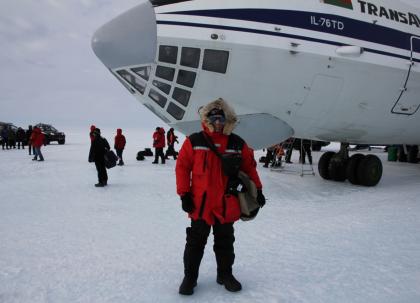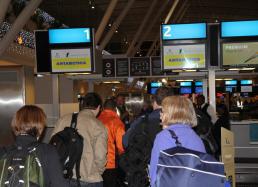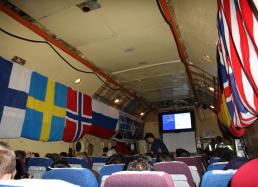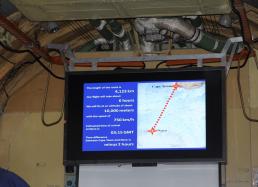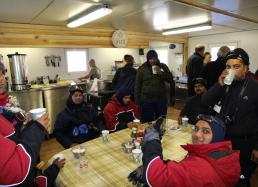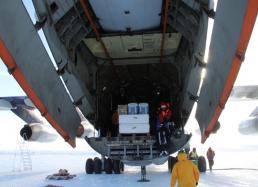2. Arriving in Antarctica
On a very windy evening in Cape Town, with my base layer of polar clothing in place, I was picked up at my hotel—along with a team of international inspectors from the U.S. National Science Foundation, the U.S. State Department, and their Russian counterparts—and driven in a van to the airport. (The inspectors were planning to visit several stations in East Antarctica to ensure that each is following the regulations outlined in the Antarctic Treaty.)
For the flight to Antarctica, our logistics contractor, ALCI (Antarctic Logistics Centre International), uses Cape Town International Airport and employs similar check-in procedures as those for regular flights. Of course, I had to take a picture of the check-in counter, which displayed the unusual destination of Antarctica (see Photo #1 below.)
My travel plans caused an interesting moment at the duty free shop: When the lady at the register asked me for my final destination, I had to assure her that I wasn't joking when I told her where I was to fly! Flights from Cape Town to Antarctica aren't frequent; there are probably only about six flights per year.
As our takeoff window was very tight, we had to board exactly at the scheduled time. We climbed into the impressive looking Ilyushin-76 and placed our cold-weather clothing bag behind the last row, then took our seats. The lack of passenger windows was unusual and the sound isolation was no match for the roar of the four engines.
The first announcement was quite funny, “Please turn off all your cellphones for take off, you won’t need them anymore anyway [in Antarctica].” After the engines were running at higher power, it was so loud that all other announcements had to be made on a video screen (see Photo #2 below.)
Another unusual sight: the restrooms were just two portable, blue-plastic port-o-potties, the kind you usually see at construction sites or outdoors festivals. Not surprising, considering this successful plane was designed to serve primarily as a cargo transporter.
After takeoff, a sandwich and beverages were served, and documentaries on life in the Polar Regions were shown (see Photo #3 below.) During the six-hour flight, most passengers (including me) managed to get a few hours of sleep, until we were woken up about 80 minutes before landing in order to don our polar clothing. As you can imagine, it was quite a challenging task in the tight space to find my bag in the pile of other bags, to get the clothes out, and to put them on—I didn’t even manage to take pictures of this exercise!
After about 20 minutes of struggling to get dressed, everyone was ready when the plane approached the Novo ice runway and made a beautiful, soft landing. As soon as the door opened, chilly air entered the cabin and everyone was quick to close their jackets and put on their gloves and caps.
A descent down a steep ladder brought us onto the slippery ice runway (see top photo.) The glare was very intense and glacier sunglasses were a must, as was sunscreen. The bright sunlight makes you realize that it’s summertime here, despite the freezing temperatures of 14°F (-10°C) and the very strong and icy wind, which I could feel despite all my layers of polar clothing.
Before starting to unload cargo and luggage, ALCI invited us into their new canteen for a welcoming cup of hot tea (see Photos #4 & 5 below.) After that, it took about an hour or two—I lost track of time—to unload all the cargo. The Indian Team had several Pisten Bullies ready for transporting us, the cargo, and our luggage (see Photos #6 & 7 below) to Maitri Station, our next destination.
It was actually a quite comfortable one-hour ride over the glaciers and rocks to the station, which is located in the Schirmacher Oasis, a virtually ice-free region. Pisten Bullies are excellent on snow and ice, but can also handle rocky terrain. We received a very warm welcome at Maitri and began the day by introducing ourselves to the current inhabitants of the station.
In the end, the trip from Africa to Antarctica was actually smoother and much more comfortable than I anticipated. My next trip—fieldwork at a remote camp—will take place tomorrow, and I probably won’t have access to the internet for a few days until I return to Maitri Station, so stay tuned!
More soon,
Philipp R. Heck, Ph.D.
The Robert A. Pritzker Assistant Curator of Meteoritics and Polar Studies
A Tawani International Expedition

